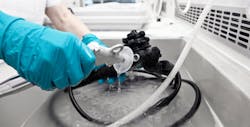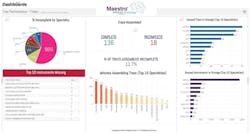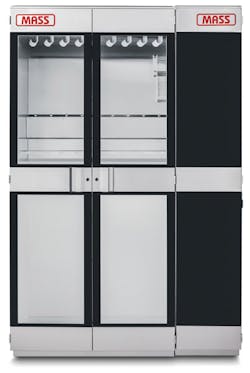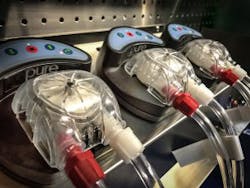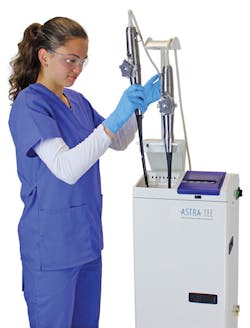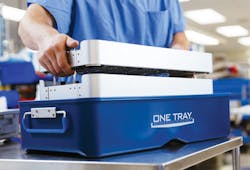Healthcare is a fast-paced, high-pressure, constantly changing environment where no day is ever the same and each individual’s tasks are impacted by countless variables, most notably patient conditions. While many central sterile/sterile processing departments (CS/SPD) are located away from the clinical setting, the work of CS/SPD professionals is directly influenced by what is happening in the operating rooms (ORs) and other patient care areas. If clinicians are confronted with unexpected cases or a surge in volume, the CS/SPD feels this pressure too and must be prepared with adequate staff, instrument inventory and processing equipment to meet the needs of their clinical customers and their patients.
Unfortunately, most CS/SPDs do not have the resources — staff and inventory/equipment — they need to comfortably process even their everyday volumes, let alone emergent situations. They are challenged with making the most out of what they have, which means uncovering ways to improve reprocessing efficiency without skipping steps and jeopardizing quality.
Assess current state
Before CS/SPD professionals can take steps to improve their department’s reprocessing turnover efficiency, they must first take a step back to assess their current state for process breakdowns. Michael O’Brien, Chief Technology Officer at Applied Logic, explains how barcoding compliance at key process points in the CS/SPD is critical to accurately understanding a department’s throughput and true productivity, before improving it.
“We’ve witnessed many departments unable to credit their people for work they already do,” said O’Brien. “As a starting point, one of our larger CS/SPDs began looking at compliance in decontam. We discovered that only two out of every three trays reprocessed by CS/SPD were scanned in the decontam area; meaning they were not capturing 30 percent of their trays entering decontam. Working with this client, we walked through their reprocessing structure and identified other compliance breakpoints; reinforcing that the most influential tool CS/SPD has at their fingertips is their department data.”
CS/SPD can track the complete instrument cycle from decontamination to the OR using Applied Logic’s Maestro surgical inventory management system. Maestro is case-driven, automatically prioritizing tray assembly needs based on a facility’s surgical schedule. The company has also launched Nimbl, the industry’s first mobile app for iOS/Android.
Nimbl alerts and communicates with Maestro users on inventory, staff, loaner and sterility actions happening in real-time.
Applied Logic’s collaborations with other tech leaders, including IBM Watson Analytics and Microsoft, help advance Maestro dashboards and reports so its clients can easily and securely predict staff scheduling needs, identify staff productivity (and compliance), trend instrument usage by procedure, and much more.
Educate staff
Sterile processing has been described as both an “art” and a “science.” While there are clearly defined steps for each stage of the process — receiving, cleaning and decontamination; preparation and packaging; sterilization; and storage — it is human-driven; therefore, open to subjective decisions, and human error. When the OR is banging down the door demanding instrument sets ASAP, it is natural for CS/SPD professionals to feel tempted to skip some steps.
According to Rick Daussat, Director of Clinical Education for Northfield Medical, proactive instrument inspection — testing to ensure every instrument is in working order, before it reaches the surgeon’s hands — is one step that CS/SPD professionals sometimes skip in an effort to meet OR demand.
“It takes time to properly process a set of instruments,” said Daussat. “One of the key issues contributing to poor instrument set turnover has always been limited inventory to support increasing demands. This puts a tremendous burden on the processing staff to ‘reprocess the set as quickly as possible,’ often leaving out some of the most important steps in the cleaning and proactive inspection. The Sterile Processing staff may become reactive in their approach to inspecting surgical instruments. This means that the instrument is only replaced in the set when the OR staff ‘tags it’ after unacceptable performance. Proactive inspection has often gone by the wayside due to the ‘rush’ brought on by the combination of insufficient inventory and surgical demand.”
Daussat points out that CS/SPD staff education is critical to ensuring each instrument set is completely and properly reprocessed. Northfield Medical, one of the largest service and repair companies of medical equipment in the U.S., has doubled the size of its education team. The company now has six regional educators throughout the country delivering over 20 certified programs (IAHCSMM, CBSPD and CBRN CEUs) for CS/SPD and OR staff via in servicing, webinars and regional conferences. Also, Northfield Medical specializes in the repair of endoscopes, surgical instruments and other OR equipment, while offering consultative support and education to help facilities increase financial savings and improve patient outcomes.
Evaluate instrument inventory and equipment
Joe Carey, Product Manager for Microline Surgical, says a great place to start with reprocessing turnover improvements is a careful review of current instrument utilization, tray composition and instrument platform.
“There is no perfect solution; keep in mind there are many options and tradeoffs to consider between fully reusable, disposable and reposable instruments,” said Carey. “As it relates to reprocessing, fully reusable laparoscopic hand instruments are broken down into three components for cleaning (handle, inner- and outer-shafts). If six reusable instruments are presented during a case, it results in 18 total parts (6 instruments x 3 components each) to be handled, cleaned, washed, flushed, checked for electrical safety, sterilized and repackaged after EVERY case. Partnering with an instrument vendor who specializes in identifying the hidden costs associated with laparoscopic instrumentation can result in immediate and significant time/cost savings.”
Because contaminated scopes present significant risks to patients, and their reprocessing is often complex and time/labor intensive, it is an area that CS/SPD professionals must carefully consider when addressing process efficiencies.
“Stress can build up when stock is kept too lean, which means it’s important to ensure that each facility has enough scopes, enough automated endoscope reprocessors (AERs) and enough staff members for the case load,” said Mindy Benedict, MS, CFER, Manager, Infection Control Program, Olympus Corporation of the Americas. “Workflow improvements can also improve turnover without risking missed reprocessing steps. For example, manually drying one scope at a time not only ties up the scope and the staff member, but it can unnecessarily expose a reprocessed scope to airborne contaminants. Facilities are looking for ways to replace such time-consuming steps while adhering to proper reprocessing protocols. They are finding new market solutions, as well as sometimes using automated tracking and management software to pinpoint new opportunities for improvement.”
Olympus advises a fully stocked reprocessing toolkit of scopes, AERs and staff, and is also addressing lengthy steps such as endoscope drying with infection control solutions. The ChanlDry Drying Cabinet can free up staff by pressure-drying up to nine scopes at one time. Other solutions for workflow include the Endo SafeStack transport cart, with at-a-glance identification of clean vs. dirty scopes to help prevent cross contamination, as well as ordered stacking to reduce the risk of reprocessing delays. Olympus’ Unifia GI-focused software platform gives healthcare professionals greater visibility and operational awareness of the endoscopes in their departments. Tracking through RFID and other automated features ensures all endoscopes are reprocessed correctly, while helping to manage workflow so that no steps are missed even under stressful conditions.
Embrace automation
“Reprocessing turnover times can be improved by utilizing automated flushing systems like our FlexiPump Independent Flushing System,” said Dan Gusanders, Founder and President of Pure Processing. “The FlexiPump allows technicians to copiously flush channeled instruments during pre-cleaning. The system is capable of flushing multiple instruments at once and has programmed flush cycles for consistent, repeatable flushing, unlike we see with the use of syringes and spray guns. While the FlexiPump flushes internal instrument channels, technicians are freed up to perform other tasks. An added bonus is that technicians no longer experience the pain and difficulty associated with traditional flushing methods. Not only does productivity greatly improve, but employee safety and satisfaction is positively enhanced.”
Investing in automated reprocessing equipment simplifies the disinfection process while maintaining compliance standards, said Ryan Swartz, Director of High-Level Disinfection at CIVCO Medical Solutions. “Choose a high-level disinfection system that reprocesses quickly but also optimizes the process to best utilize your staff’s time. For instance, look for a system that 1) can reprocess more than one device at a time, 2) does not require personnel to monitor the equipment while it’s reprocessing devices, and 3) automates the logging of reprocessing events.”
The ASTRA automated high-level disinfection system from CIVCO helps make compliance simple in the reprocessing of transesophageal echocardiography (TEE) and endocavity ultrasound probes. ASTRA standardizes speed by disinfecting up to two probes at once with a total reprocessing time of nine to 13 minutes, depending on the type of probe and disinfection solution. Clear, easy-to-follow steps guide the user through the setup process before automated probe reprocessing begins. The system will not go to sleep mode during or after the cleaning process, giving staff time to focus on other tasks while keeping probes safe. ASTRA is compatible with three off-the-shelf, reusable disinfectants to save departments money: Revital-Ox RESERT, CIDEX OPA, MetriCide OPA.
Eliminate dry time
While steam sterilization is an effective, fast and inexpensive modality, CS/SPD professionals must factor in adequate dry time to prevent moisture in both wrapped and containerized instrument sets. The sterile processing team at UPMC Pinnacle Hanover was able to eliminate both dry time and the use of immediate-use steam sterilization (IUSS) through Innovative Sterilization Technologies’ (IST) ONE TRAY Sealed Sterilization Containers.
“We have significantly reduced turnover time for instrumentation and are still able to follow the manufacturer’s instructions for use for cleaning and sterilization,” said Dawn Olson, BSN, RN, CNOR, CRCST, Nurse Manager, Central Sterile Supply, UPMC Pinnacle Hanover. “We can now have terminally sterilized items ready for patient care within two hours. All other forms of terminal sterilization require a dry time due to the wetness and permeability of the filters. This requires a minimum of four hours. With ONE TRAY we do not have to worry about the filters drying so the product is ready when the cycle is complete. We have reduced our IUSS to zero.”
Get rapid results
The final step in the process — sterility assurance — is another “hurry up and wait” task encountered in the CS/SPD. In the past, CS/SPD professionals had to wait hours, or even days, to obtain the results from biological indicators (BI) used for load monitoring. But new BI technology has sped up the process, according to Srini Raman, 3M Business Director of Device Reprocessing.
“To improve reprocessing turnover, successful SPDs work to standardize and streamline the workflow to meet the demands of both speed and quality,” said Raman. Recent advancements in sterile processing assurance technologies have helped make this easier. For example, some biological indicators can now provide a readout in as little as 24 minutes, as opposed to waiting hours or even days. In addition, some auto-readers can read both steam and vaporized hydrogen peroxide (VH2O2) BIs in any incubation well simultaneously. Implementing these new technologies can help SPDs reduce workflow errors and bring consistency to the process to help ensure every instrument is safe for patient use.”
3M recently received FDA 510(k) clearance for the Attest Super Rapid Biological Indicator System for steam, which has all of those features, making the practice of every load monitoring increasingly feasible. Facilities can implement the new 24-minute system through a software upgrade to existing 3M Attest Auto-reader 490 and 490H units to reduce risk and enhance efficiency in the SPD.
About the Author
Kara Nadeau
Senior Contributing Editor
Kara Nadeau is Sterile Processing Editor for Healthcare Purchasing News.
